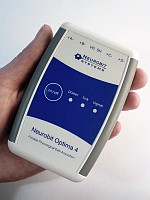Neurofeedback origin
In 1924 Hans Berger designed the first electroencephalograph (EEG) - a device enabling graphical recording of brain electrical activity as measured on the scalp. Taking measurements from his son, Berger observed rhythmic changes in the potential of the 10 Hz frequency. This activity, predominant in the state of relaxation, became known as Alpha waves (8-13 Hz). Further research made possible identification of other types of brainwave activity, related to particular states of consciousness:
- Delta waves (0..4 Hz) - appearing in the deepest sleep;
- Theta waves (4..8 Hz) - predominating mainly in sleep as well as during particularly realistic visualizations, for example;
- Beta waves (13..about 30 Hz) - typically appearing in adults during daily activity.
In practice, particular types of waves usually occur jointly and in various proportions, depending on the location in the brain.
In 1958 Joe Kamiya decided to study whether we possess the ability to subjectively differentiate between the kinds of waves generated by our own brains. A person examined with an electroencephalograph was instructed to answer at random moments on hit-and-miss whether he was in "the Alpha state". Afterwards, he was informed whether his answer had been correct. Initially, mistakes were about equal in number to hits. However, the number of hits grew in renewed attempts over the following days. After four days, the answers were faultless. What's more, the subject was able to reach the Alpha state "on request". Kamiya soon developed an improved version of the apparatus, automatically providing a feedback signal in the form of a tone at the moment of predominance in Alpha waves. Using the equipment, he demonstrated that it was possible to learn conscious control of a general mode of brain activity, thereby controlling the state of consciousness and quality of mental functioning. In this way neurofeedback came into being.
In 1971 Barry Sterman initiated therapeutic applications of neurofeedback. Training which increased the level of so-called SMR waves (tested initially on animals) turned out to reduce the frequency of epileptic seizures for humans. Toward the end of the seventies, Joel Lubar began research on applications of the method for children with attention deficit disorders (ADD) and hyperactivity disorders (ADHD). Effects observed turned out even better, often substantially better, than results obtained with drug treatment or with classic psychotherapy. Treatment for ADD/ADHD is the most frequent application of neurofeedback today. In the following decades the method was applied to other psychophysiologic disorders, including anxiety, addictions, depression, and posttraumatic stress disorder (PTSD).
For a long time, price ($5,000-$20,000) and quality of necessary equipment were barriers to the more widespread use of neurofeedback. Only at the beginning of the 90s, in connection with more widespread use of personal computers, did relatively inexpensive devices ($1,000-$5,000) become available.
The other major barrier to development of neurofeedback was an initial lack of understanding in professional society. The method referring to terms like will, consciousness, or self-regulation, was going beyond the "mechanical" paradigm of natural sciences of the time. The year 1999 turned out to be a breakthrough when Academic Press published the first scientific monograph on neurofeedback. Now, American insurance companies are covering the costs of treatment of attention disorders with the method. The number of scientific publications in the field increases every year. Developed initially in the United States, neurofeedback is now becoming known in other countries as well. A few years ago, overseas institutions were founded, such as the Biofeedback Foundation of Europe and the European branch of the International Society for Neuronal Regulation.
A separate discipline makes up the non-therapeutic application of neurofeedback to peak performance training - in order to enhance mental performance and increase immunity to stress.
If you want to learn more about peak performance training...
-
Frequently asked questions - Accessible explanation of mental peak performance training.
-
Research - Survey of scientific discoveries connected with neurofeedback in peak performance training.
-
Neurobit Optima - Versatile multi-channel equipment for neurofeedback, biofeedback and physiological data acquisition.
-
Links - Sources of additional information on neurofeedback.
